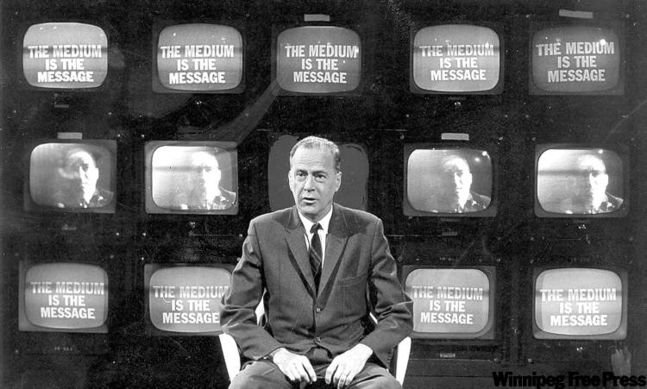By Jonathon Van Maren
Many may not recognize his name, but like Neil Postman’s Amusing Ourselves to Death, Marshall McLuhan’s famous phrase “the medium is the message” has entered the mainstream consciousness as a term that captures our times. I was first exposed to McLuhan in university, when one of my professors insisted that we all read McLuhan’s somewhat bewildering little book The Medium is the Massage—a typo that McLuhan liked so much he decided to keep it that way.
Few Canadians become internationally famous, but University of Toronto professor Marshall McLuhan could claim that distinction, regularly appearing on American television to debate men like Norman Mailer, who like many others felt that he might agree with much of what McLuhan was saying if only he could understand it all. One writer in The Walrus even noted that McLuhan “has strong claims to being the most important thinker Canada has ever produced,” noting that his critiques and analyses of the emerging media landscape would appear, in later years, to be prophetic. He noted the fundamental power of advertising and television to dehumanize people, and predicted that the modern media age would create a “global village” where everyone would be connected by technology—but that ironically, this would usher in a new age of tribalism
What few Canadians know is that Marshall McLuhan was actually very troubled by the advent of legal abortion, and spent much time brainstorming on how to reach people with the sad truth that abortion ended the life of a human being. McLuhan took part in a pro-life demonstration in Ottawa among others, and spoke at a conference on abortion in 1972. McLuhan even wrote to Pierre Trudeau, urging him to change course on the issue. I have not been able to uncover McLuhan’s letter or letters to Trudeau, but I have discovered, in published posthumous letters, a missive to J.M. Davey, the program director for Trudeau dated September 29, 1971:
I want to ask your counsel and aid in some anti-abortion strategies which I am beginning to be associated with. The abortion mill closely resembles Buchenwald. People directly engaged in it would risk their lives to save the life of a two-year-old child from a car or truck. What has happened is a complete collapse of community awareness via specialism of function. As long as an operation or process is divided into sufficiently small segments, nobody feels any responsibility for anything. Communal awareness has no chance to come into play. This was the mystery of Buchenwald and such camps. A few weeks ago I spoke with Germans and Austrians directly related to those events. They were pious Catholics, and I asked how they could have permitted these things. Their answer was simply “We just did our bit and were unaware of the other bits.” It is by this type of programming that we can calmly expect our highways to deliver a given number of dead per day or week. The really devastating programming is the destruction of perception and sensitivity by the creation of vast environments far exceeding human scale. The King Kong fantasies are direct expressions of the feeling most people have in their environments which have become monsters. Yet, the best intentioned bureaucrats in all governments are busily engaged in creating bigger and blacker King Kongs every day of the week. Meantime, the kids are repudiating the society and fleeing to small communes. Of course, the effect of current unemployment will be to reconcile many of them once more to the environment as it is.
Our anti-abortion group here at St. Mike’s [St. Michael’s is a Catholic College and part of the University of Toronto] need to discover ways of presenting films on national networks, if possible. These films don’t have to have any pro or con slant, if they are permitted to show the actual process. If any practical program has begun anywhere that you know of, I would be happy to hear about it. Hoping you have had a good summer, and that your family is in the best of shape,
Warm regards,
Marshall
McLuhan understood that in a society where white noise was prevalent and communication was constant, people needed to be confronted with evidence of abortion’s barbarism that would cut directly through the noise and once again highlight to people that the human being developing the womb was an individual deserving of protection. His solution, which would have been tremendously effective if implemented, was to show people videos of the abortion procedure without comment. The evidence alone, McLuhan believed, would be enough to sway people. He wrote further on how the hidden nature of abortion contributed to public acceptance of it in a letter to the editor of the Toronto Star that was published on July 3, 1974:
Dear Sir,
Without rehearsing the arguments in the abortion matter, I would like to draw attention to some of the hidden ground of this matter. As people become more deeply involved in each other by the sheer speed of information which covers them, there is a very great loss of private identity, with the consequent insecurity and rage and violence. When instant information exists around the entire planet, there is, as it were, inflation of human quantity which threatens all human values whatever and eliminates the experience of private identity. When identity is weak, all constraint and social restriction become intolerable.
Paradoxically, it is the sheer involvement of everybody in everybody which creates the illusion that new life is cheap and even superfluous. Nothing could be more misleading than trendiness in such matters. Electric speeds of information literally create the mass man and obliterate the private man. If this can be called a trend, it is a trend to the loss of all live values whatever. At the old slow speeds of information, before the telegraph, there were habits of detachment and objectivity with don’t hold up against the total involvement and immersion in the World Tank.
Abortion “thinking” has all of the characteristics of the panicky trends of the radio age in the 20’s, which produced Hitler and Stalin, with their mass followings. Abortion “thinking” is taking place in an even deeper swamp of mass hysteria created by the inner trips of the TV image. It is important to realize that all of our thinking about abortion is taking place in the smogged-over world of TV. It is becoming monstrous to even mention the individual rights of the born, or the unborn. Only huge categories will serve, such as the “rights of pregnant teenagers” or the “rights of all pregnant mothers. Only very large quantities of organic material (crowds) can now command attention.
The quantity of the world population becomes a very strong argument against mankind. The current inflation itself seems to be a basic assumption behind abortion “thinking”. Pregnancy becomes a kind of “inflation” and abortion becomes a happy expedient for inflation control. Pregnancy as an irresistible kind of inflation endangers the mother’s psychic income, reducing her standard of “living.”
Is it too late to point to our universal victimization by media in which private identity has been abolished? For trendy people, the destruction of private identity by instant information involvement is a mandate to attack all forms of private life which remain. There are many people for whom “thinking” necessarily means identifying with existing trends. If medical and laboratory science can spawn human organisms as readily as fungus, then this trend means that we must deal with all existing organisms as expendable fungus. However, the trend to the democratization of nuclear warfare still seems to give pause to a few (now that everybody can make his own atom bomb). Perhaps tends cannot always be trusted. The trend toward increasing enlightenment by electric media has flipped us back into the world of the occult, that is, the world of horoscopes and hidden forces. Abortion “thinking” is entirely in accordance with the trend toward the mechanization of death and of birth alike. The meat-packers have got there “firstest with the mostest.”
Evidence that McLuhan’s proposal to impact public opinion on abortion by displaying the end result of the procedure would have worked is now easy to find: polling data has consistently shown that the power of abortion victim photography to sway hearts and minds is enormous. In fact, when abortion was show in the United Kingdom on the BBC, The Independent reported on October 21, 2007, that the impact was nearly immediate:
Last Wednesday a Dispatches programme on Channel 4 showed shocking images of the remains of foetuses pulled or sucked from the womb in bits: Long, slick trails of blood and jelly-like tissue containing a tiny foot here, or a hand with five translucent fingers there. ‘We are quieter than usual today,’ says the clinic manager, who says women have cancelled after seeing the film.
Marshall McLuhan was right on many things—how mass communication would begin to consume our lives, how mass media would begin to destroy our individual identities, and how the “global village” would eventually allow us to identify those who thought just like us and form “tribes” that would supersede local communities. He was also right that abortion remained acceptable to many people because they had never been confronted with the reality of what it was: the destruction of another human being—and that by showing people, many of those human beings could be saved.
________________________________________________
For anyone interested, my book on The Culture War, which analyzes the journey our culture has taken from the way it was to the way it is and examines the Sexual Revolution, hook-up culture, the rise of the porn plague, abortion, commodity culture, euthanasia, and the gay rights movement, is available for sale here.








